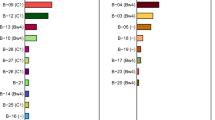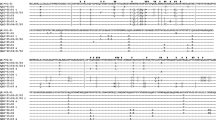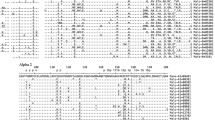Abstract
Human immunodefiency virus (HIV) poses a major threat to humankind. And though, like humans, chimpanzees are susceptible to HIV infection, they are considered to be resistant to the development of the acquired immune deficiency syndrome (AIDS). Little is known about major histocompatibility complex (MHC) class I diversity in chimpanzee populations and, moreover, whether qualitative aspects of Patr class I molecules may control resistance to AIDS. To address these questions, we assayed MHC class I diversity in a West African chimpanzee population and in some animals from other subspecies of chimpanzee. Application of different techniques allowed the detection of 17 full-length Patr-A, 19 Patr-B, and 10 Patr-C alleles. All Patr-A alleles cluster only into the HLA-A1/A3/A11 family, which supports the idea that chimpanzees have experienced a reduction in their repertoire of A locus alleles. The Patr-B alleles do not cluster in the same lineages as their human equivalents, due to frequent exchange of polymorphic sequence motifs. Furthermore, polymorphic motifs may have been exchanged between Patr-A and Patr-B loci, resulting in convergence. With regard to evolutionary stability, the Patr-C locus is more similar to the Patr-A locus than it is to the Patr-B locus. Despite the relatively low number of animals analyzed, humans and chimpanzees were ascertained as sharing similar degrees of diversity at the contact residues constituting the B and F pockets in the peptide-binding side of MHC class I molecules. Our results indicate that within a small sample of a West African chimpanzee population, a high degree of Patr class I diversity is encountered. This is in agreement with the fact that chimpanzees display more mitochondrial DNA variation than humans. In addition, population analyses demonstrated that particular Patr-B molecules, with the capacity to bind conserved HIV-1 epitopes, are characterized by high gene frequencies. These findings have important implications for evaluating immune responses in HIV vaccine studies and, more importantly, may help in understanding the relative resistance of chimpanzees to AIDS.
Similar content being viewed by others
Author information
Authors and Affiliations
Additional information
Received: 8 December 1999 / Accepted: 30 December 1999
Rights and permissions
About this article
Cite this article
de Groot, N., Otting, N., Argüello, R. et al. Major histocompatibility complex class I diversity in a West African chimpanzee population: implications for HIV research. Immunogenetics 51, 398–409 (2000). https://doi.org/10.1007/s002510050638
Issue Date:
DOI: https://doi.org/10.1007/s002510050638




